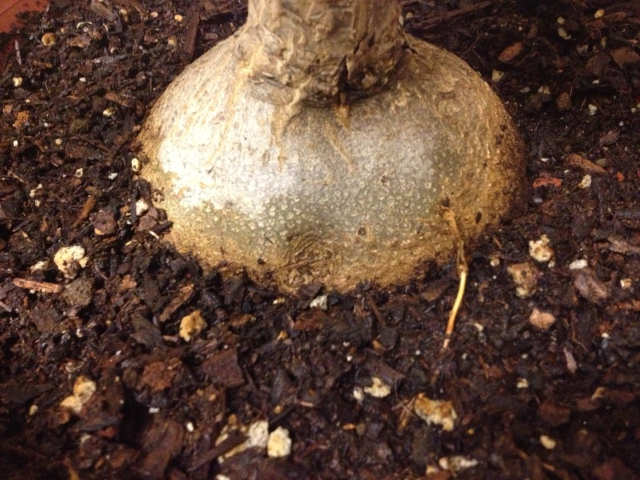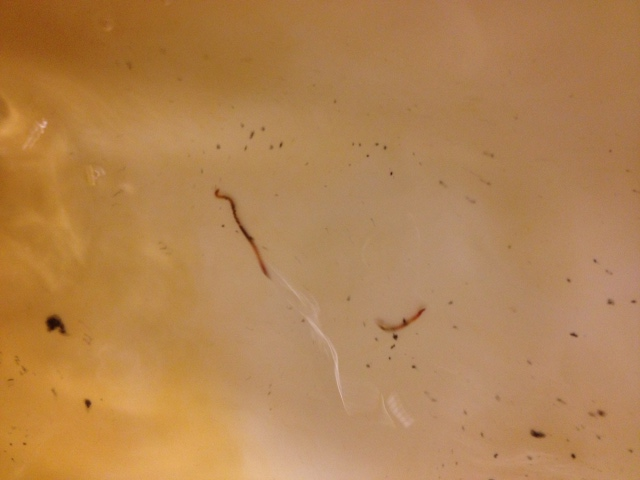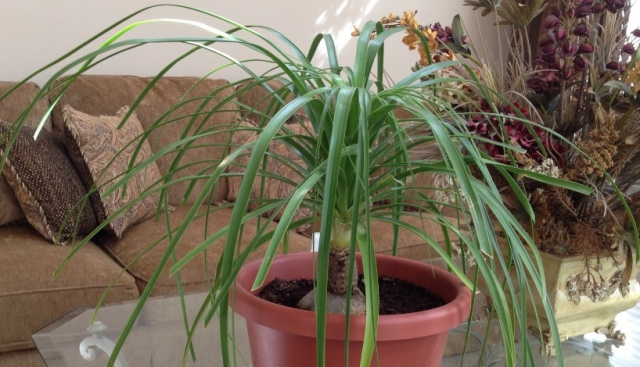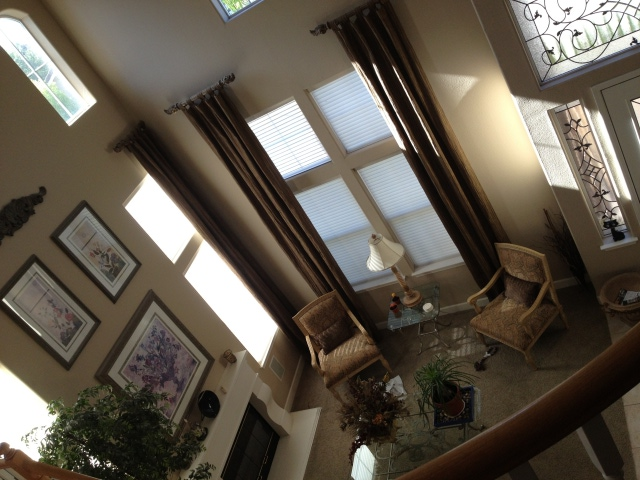Question Palm base.
Palm base.
 Two worms.
Two worms.
QUESTION: I was watering my ponytail palm for the first time since early/mid-may to be sure the soil is thoroughly dried. I even use a moisture gauge just to be 100% sure. I placed the pot in water to bottom water it. When I go back, after pouring a cup of water from the top, I picked up the pot and saw three long skinny worms in the water. I haven't seen any like these before. I also noticed a small finger nail sized indent in the bulb which wasn't there before. The bulb and stem are completely hard but just this one spot was very slightly soft. Not terribly concerning at the moment. I'm mentioning just for the sake of possibly being related to the long worms I found in the water. Also, since I bought this plant back in January the new growth hasn't been perky, straight up, which seems to be the norm for this plant. I believe that's just because I repotted it upon bringing it home because there was gnat larvae in the soil and was in shock to the larger pot (only size that would fit the roots). But other than the diminished new growth perky, straight up look, the new growth doesn't stop and the leaves are completely healthy. This is an indoor only plant, so I'm kind of perplexed.
ANSWER: Hi Katy,
You have some basic misunderstandings about caring for your Ponytail Palm and are focused on the wrong things.
You didn't include a photo of the entire plant, which would have been helpful, but I can see that there is way too much soil surrounding the base bulb. Ponytail Palms must be kept potbound at all times and the pot should be no larger than an inch wider than the width of the bulb. In other words, there should be no more than a half-inch of soil between the bulb and the edge of the pot. I am 95% sure that your Ponytail Palm did not need to be repotted in the first place. Therefore, I suggest, you undo the repotting by removing all of the (contaminated) soil that you used and put the rootball into the smallest pot that it will fit into snugly. Fill in spaces with a potting mix of 3 parts peat moss and one part perlite. This mix will be pest and disease free.
By keeping the plant very potbound, the soil will dry out more quickly and prevent root rot. Ponytail Palms are native to arid regions and can withstand drought, but not constantly damp soil.
Moisture meters are notoriously inaccurate so I strongly recommend you stop using it. Use your finger or a wooden stick to determine when the top half of the soil in the pot is dry before adding water. Water slowly from the top and stop as soon as a bit of water starts to trickle through.
Although Ponytails will survive in reduced light, they do much better on a sunny windowsill. In strong light, the leaves are thicker and more upright. In reduced light, the leaves are thinner and arch over.
I have written articles on repotting and on Ponytail Palm care that I will email for free to you (or anyone else) who emails a request to me at
[email protected]. I have also written an indoor plant care book in a PDF format that I can sell you if you contact me at my email address.
Please let me know if any of this is unclear or if you have any additional questions.
If this information has been helpful, please click the Rate Volunteer bar below and enter a rating and NOMINATION for me. I am a volunteer on this site so Ratings are the only compensation I receive for answering plant questions.
Need more information? Visit my website at:
A link to HorticulturalHelp.com
or email me at
[email protected] or call me at 917-887-8601 (EST)
Regards,
Will Creed, Interior Landscaper
Horticultural Help, NYC
Visit my website at: A link to HorticulturalHelp.com
---------- FOLLOW-UP ----------
 Pony palm
Pony palm
 Windows
Windows
QUESTION: I understand the care they need and that was the smallest pot I could find. Stores are notorious for not having the size pot the same size or just larger than the nursery stock plant container they come in. All the others were drastically too small. The bulb is also misleading in size, the largest part being just under the soil out of view. I made sure to fill to the same spot the soil was up to before. This is just a simple gauge that blinks if it's dry and stops when it's moist. I tried it on my other plants to see how accurate it readings were, adjusting accordingly. The roots of my palm have already reached the bottom of my pot as they are coming out the bottom drain holes. It's also in the brightest area in the house without actually being outside as it receives (the room) full eastward sunrise and afternoon sun and isn't directly on the plant. They only allow two picture uploads and I uploaded the two that, in my opinion, pertained to my specific question of what the worms were that came out the bottom of the pot when I watered my 2/3 dry soil. I'll try AGAIN to look for a smaller pot but I'm still more than certain there won't be any the right size, as I've already looked last week, unless I take a pottery class and make it myself.
ANSWER: Hi Katy,
I was trying to be helpful, not critical. Thanks for the additional photos.
Do what you can about the pot size, but be sure the soil gets really dry deep in the pot before watering.
The location of the plant will provide minimum survival light at best. That is another reason to keep it very dry.
The worms came with the soil you added. They will not harm the plant. Next time the plant needs water, set it in a sink or tub with water up to the rim of the pot. Let it sit for about an hour. Any critters in the soil will leave the pot in search of air.
~Will
---------- FOLLOW-UP ----------
QUESTION: I didn't mean to seem attacking. It's just you went right over the concern of worms I was questioning about and I believe I had mentioned at least once in my initial question my knowledge of knowing how large the pot is for the plant. I had originally purchased a pot I believed would be the perfect size for the plant, but as soon as I placed it in there were only room for the massive root ball and none for the bulb, even though the circumference was perfect for the bulb size, which also was misleadingly larger than what I saw on the surface. The pot it's in now was literally the next size up without it being a self watering pot. I cringed as I potted it knowing I'd have to watch it closely. The picture of all the windows focused in a way that made it appear significantly darker than it actually is. It's nearly as bright as if you placed a plant on a shaded outdoor porch just out of reach of the direct sun rays. I'll take the plant out of the pot later, rinse the roots and cover them with a bag and we'll go try on every pot there is to offer in my town. Since the worms are harmless, as you say, I'll dump the soil in my yard and let them be free. I don't like having to kill things that didn't do anything wrong, even if it's an insect. I blame my bleeding heart of a veterinary tech. I'll update you on my pot search.
AnswerI'm sorry I wasn't more clear in my first reply. When I suggested you replace the "contaminated" soil you added and use a mix that would be pest and disease free, I should have mentioned that I included worms in the categories of contaminated and pests.
In my experience, most people do not know the proper size pot for plants even when they think they do. I don't know you, but I will refrain from adding any information other than answering specific questions you have. I disagree with your assessment of the light based on its distance from the windows, but I will leave it at that.
~Will









